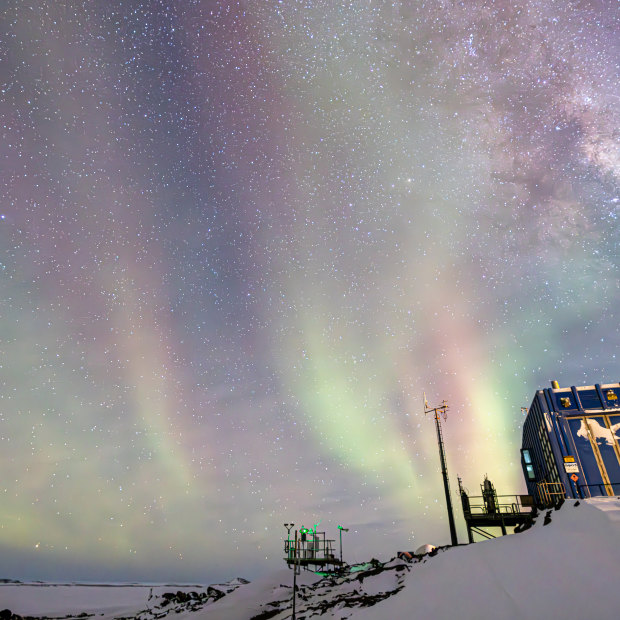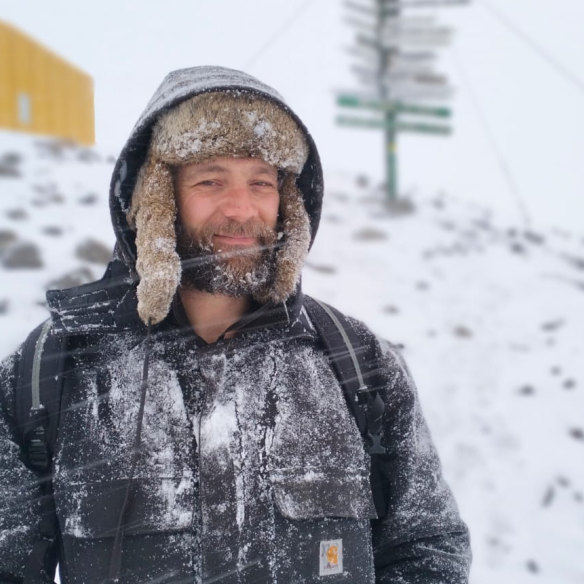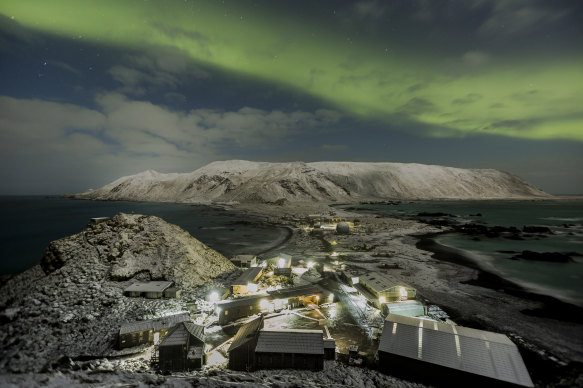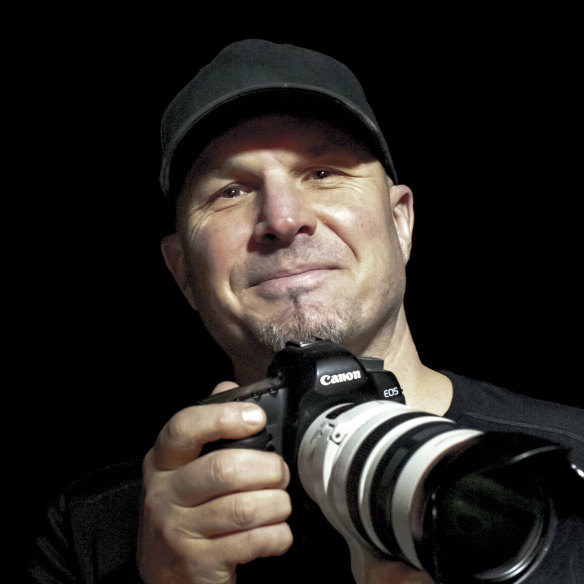This was published 4 months ago
When two tradies in Antarctica had time off, they snapped pics like this
Australia recruits a handful of tradies to help man its three Antarctic stations each winter. This year, in an unexpected bonus, two of them turned out to be excellent photographers.
By Tim Elliott

“A thin covering of cloud turned the ordinarily electric-green and red aurora into a spread of pastels above the Bureau of Meteorology building,” says photographer and Antarctic station carpenter Jared McGhie.Credit: Jared McGhie
In January 2023, Jared McGhie was sitting at home in Catherine Hill Bay, just south of Newcastle, scrolling through Facebook when he clicked on an advertisement. “Are you a tradesperson who wants to work in Antarctica?” it read. The ad was on behalf of the Australian Antarctic Program, which undertakes science and research projects in the world’s southernmost continent.
McGhie, who is 42 and a trained carpenter, has always been keen on adventure. “I looked at the ad and I thought, ‘Yeah! Sounds awesome,’ ” he says. His wife and two young children were less convinced, but he spent the next two nights filling out the application. Nine months later, after a lengthy interview process, specialist training and physical and psychological assessments, McGhie was on the icebreaker RSV Nuyina, bound for what Norwegian explorer Roald Amundsen called “the lands of ice in the south”.
Australia operates three Antarctic stations: Casey, Davis and Mawson. All require regular maintenance and, in some cases, extensions. To carry out the work, the government recruits a handful of tradies every year, including carpenters, plumbers, electricians and mechanics. Hundreds of people apply, but only a handful are accepted. “The conditions are pretty demanding,” says McGhie when we speak via WhatsApp. The temperature can drop to minus 60 degrees in winter, when the sun barely makes it over the horizon. “Right now we’re bracing for a 70-knot blow [130 kilometres per hour], and so we have to make sure that everything that is loose is tied down and out of the way.”
Davis Station is spread out over 500 square metres and comprises a series of buildings, including the mess, lounge, sleeping and medical quarters, which are linked by covered walkways. The only facilities that are separate are the powerhouse and the sewage treatment plant, which are connected to the main complex by “blizz lines”, fluoro ropes that are visible even in blizzard conditions.
There are just 28 people at Davis – only three are women – including the station leader, supply officers, a doctor, tradespeople and, over the summer months, a handful of scientists there to study the climate or monitor wildlife. The isolation and living arrangements make for an intense camaraderie and sense of purpose, but it has its challenges.
“It’s small communal living,” says McGhie. “You don’t get to choose who you’re with, and everyone brings their own character and quirks.” A common bugbear is slamming doors. “They’re big and heavy and when they slam they wake you up.” A few people love whistling, which can grate after a while; others might leave their smelly shoes on the couch in the common area. Then there is the matter of music. “We have people aged from their late 20s to the mid-60s, so there are some diverse music choices, from your classic Aussie rock, Johnny Farnham to techno and Shania Twain.”
Despite the pre-embarkation screening process, it can be difficult to know how people will react. People look out for one another, and the station is proactive in creating a sense of community. There is a darts competition, and trivia and film nights. McGhie is proficient at Brazilian ju-jitsu and holds lessons for some of his colleagues. But the role perhaps closest to his heart is as the station’s resident photographer.

Carpenter Jared McGhie says he wants his Antarctic photography to stir emotions.Credit: Jared McGhie
“I’ve always loved photography,” he tells me. “In a previous life I was a tour manager for a band and I did a lot of photography for that. But what I love most here is getting out and telling a story about nature and showing it in its real form, trying to capture it and present it to other people so they can have some involvement in what I’m seeing.”
McGhie’s photography draws in large part from the immensity of the landscape. One of his favourite shots is of a colossal iceberg, the size of an office block, sculpted by the ceaseless winds, looming precariously over a freezing sea. “I cannot even begin to describe how big it was,” he says. “All while a southern giant petrel with a two-metre wingspan flies towards it, to give a little scope.”
In such surroundings, human beings seem like an afterthought. In one of McGhie’s shots, expeditioners look like ants crawling across an ice sheet; in another, the ice station is dwarfed by phantasmal auroras. “I want my photography to stir emotions in someone else,” McGhie explains. “But I also do it for the people around me, who aren’t as good at photography but want the memories.”

An aurora over the Macquarie Island Research Station, Australia’s permanent sub-Antarctic base located midway between Tasmania and Antarctica.Credit: Justin Chambers
Fellow expeditioner Justin Chambers likewise spends much of his time behind the camera. Chambers, 49, has worked at all the Australian stations since starting with the Australian Antarctic Division in 2010, and has also summered at New Zealand’s station at Scott Base. (He is a Kiwi.) He now works as the chef at Mawson, Australia’s oldest Antarctic station, almost 1500 kilometres west of Davis. “Life down here is rugged and dangerous, and you have to cherish every moment,” Chambers says. “We’re a little biome of personalities, with people from all over Australia from different backgrounds and ages.”
Living in a human fishbowl does have its advantages: “It’s easy to make friends here,” Chambers says. But it also places considerable pressure on the group dynamic. “Small things can become big things, like people not refilling the coffee machine, or not cutting the bread at a straight angle.”

Mawson chef Justin Chambers tries to “find the beauty in the nothingness”.Credit: Brendan Sainty
Establishing a reliable dispute resolution mechanism is essential, especially when you never really leave work. “At home, you leave your issues in the workplace and go home and decompress. But here, if you don’t deal with stuff, it’ll get large very quickly.”
Everyone has their coping strategies, says Chambers, who describes himself as “very passionate”. He is endlessly curious and a great talker – albeit a little digressive. “Some people get engaged with that, and the rest wonder what is going on. And that’s OK because we all think differently.”
But his main release is photography. “I’ve been interested in photography since I was at high school,” he says. “I was always interested in framing a moment on camera, but I never took it seriously.”
Antarctica gave him the space, the time and the material to fully explore it. “It ticks every box for me down here,” he says. “Depending on the subject matter and the time of day, I can use photography to gain an emotion or release a feeling. It can be happy or morose. I can’t get enough of it.”
Chambers’ work interrogates the elements, in all their starkness and spectral beauty. “It’s impossible to take a bad photo here. I mean, who gets to take a photo of an iceberg? But I try to keep going and going, to find the beauty in the nothingness. It allows me to prosper with my photography.”
His photographs speak not only to his – technical prowess but also an extraordinary level of patience. One of his favourite photos is of a single snowflake shot in such tight close-up that it resembles a piece of crystal jewellery. “It took 120 hours of photography over six months,” he says. “I’d just go back to that project again and again, to make sure I got it right.”
Such forays are not without risk. Once he was outside shooting the aurora at 11pm. “It was blowing 25 knots, and so the windchill was about minus 40.” Chambers took off his gloves to adjust the settings on his camera. Before long, his fingers were frostbitten. (He managed not to lose them.) “Sometimes you can spend two or three hours and still not get a decent photo, but still come back happy,” he says.
For Chambers, whose photos have been run in Australian Geographic, the possibilities are endless. “It’s a white, desolate land,” he says. “But it’s got a lifetime of photography in it.”
To read more from Good Weekend magazine, visit our page at The Sydney Morning Herald, The Age and Brisbane Times.